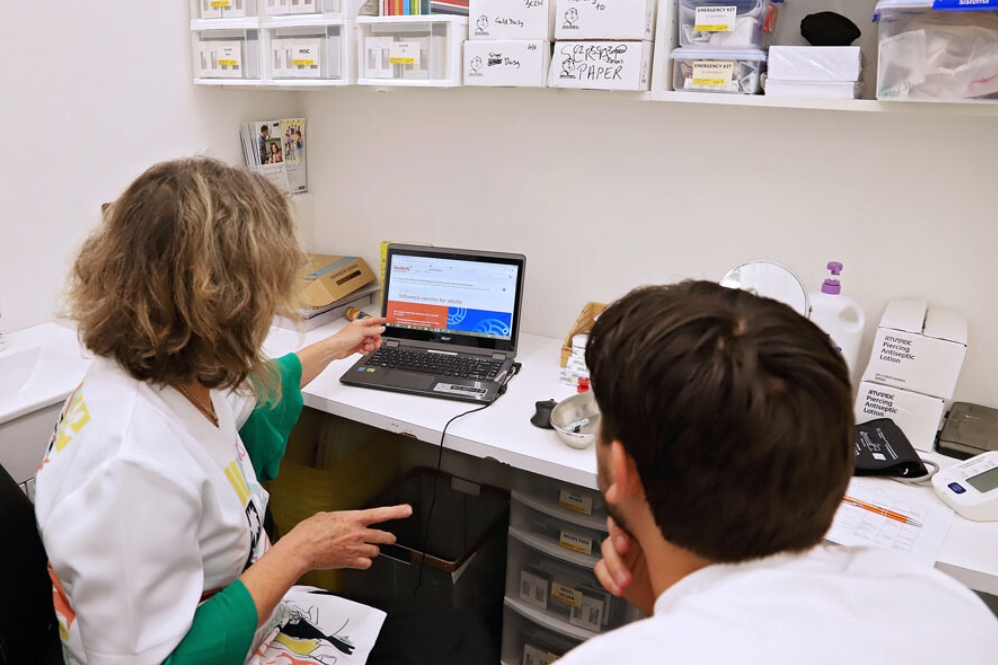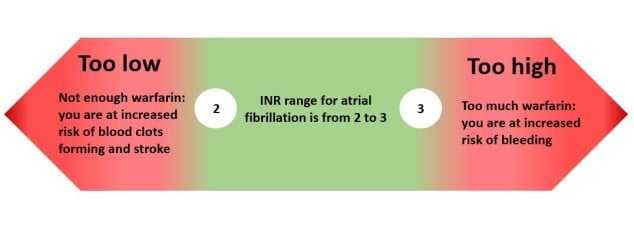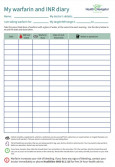Warfarin and INR
Frequently asked questions about INR
Key points about warfarin and INR
- Different people respond to warfarin differently.
- Monitoring with an INR test is needed to make sure you are taking the right dose of warfarin.
- The test is called an INR (international normalised ratio) test.

If you are taking warfarin, you will need to have regular blood tests that measure how long your blood takes to clot. The test is called an INR (international normalised ratio) test.
The goal of warfarin therapy is to control blood clots. Having too little warfarin puts you at risk of your blood clotting and having too much warfarin puts you at risk of bleeding. Therefore, the effect of warfarin must be monitored carefully with blood testing. INR tests are very important to help your doctor decide on the best dose of warfarin for you.
Your doctor will tell you what INR you should be aiming for. This is called the target INR range. Your target INR range will depend on the condition being treated.
- Atrial fibrillation (AF) – for most people with AF, the target INR range is from 2–3.
- People with mechanical heart valves may need a higher INR target range from 2.5–3.5.
An INR in the right range will prevent blood clots and reduce the risk of bleeding.

High INR: If your INR is too high, you are at increased risk of bleeding. Your warfarin dose may need to be lowered.
Low INR: If your INR is too low, you are at increased risk of blood clots forming and your warfarin dose may need to be increased.
When you start taking warfarin, you will have an INR test daily or every second day until the right dose is worked out for you. It may take 1–2 weeks to find the right dose, then a blood test is usually only needed every few weeks. How often a blood test is needed is different for everybody. After your blood test your dose of warfarin may be changed to keep the INR within the target range for you.
There are a few things that can affect your INR, such as:
- missed warfarin doses
- other medicines, including over-the-counter pharmacy medicines, vitamins, minerals, herbal medications and dietary supplements
- large changes to your diet
- alcohol.
Read more about warfarin and warfarin and diet.
Yes, you may eat and drink as normal before this test.
In New Zealand you can get your INR test done at a blood collection centre (such as MedLab) and some community pharmacies.
Blood collection centre
Across New Zealand there are blood collection centres where a phlebotomist (someone who is trained to take blood) collects a blood sample from your vein. This sample is then sent to a laboratory for analysis. Your INR result will be passed onto your GP.
At a pharmacy
Some pharmacies in New Zealand have a warfarin service called the Community Pharmacy Anti-Coagulation Management Service (CPAMS). The pharmacist measures your INR levels using a finger prick test and can tell you the dose of warfarin to take. Your GP is also informed of the INR result, as they have overall responsibility for your care. Read more about CPAMS(external link). You can find out if a pharmacy near you offers CPAMS(external link).
INR self-testing
Some people prefer to monitor their INR by themselves using a coagulation self-testing device. This device is not subsidised – you would have to pay for it in full. Talk to your doctor if you think INR self-testing is suitable for you.
You need to keep track of your warfarin dose and your INR because your dose of warfarin depends on your INR test result. Based on your INR test results, your doctor or pharmacist will talk to you about whether your warfarin dose will stay the same or needs to be changed.
The aim is to try and keep your blood clotting time within your therapeutic range so that you won't be at risk of clotting or bleeding. Make sure you understand the instructions.
There are different ways you can record your INR:
- Anticoagulation booklet (also called the warfarin red book) – this is available from your pharmacy or GP.
- Warfarin and INR diary – print the page and fill in the information. You can ask your doctor, pharmacist or nurse to help you fill it in.
- Apps – if you have a smartphone or mobile device, there are a number of apps you can use to keep track of your warfarin dose and INR result. See warfarin apps.
Brochures
Warfarin and INR diary [PDF, 131 KB] Healthify He Puna Waiora, NZ English [PDF, 131 KB], Cook Islands Māori [PDF, 246 KB]
5 questions to ask about your medications(external link) Health Quality and Safety Commission, NZ, 2019 English(external link), te reo Māori(external link)
Medicines and side effects(external link) Healthify He Puna Waiora, NZ, 2024
Apps/tools
References
- Use of INR for monitoring warfarin treatment(external link)(external link) BPAC, NZ, 2010
- CPAMS(external link)(external link) Community Pharmacy Anticoagulant Service, NZ
Brochures

Health Quality and Safety Commission, NZ, 2019 English, te reo Māori

Medicines and side effects
Healthify He Puna Waiora, NZ, 2024
Credits: Sandra Ponen, Pharmacist, Healthify He Puna Waiora. Healthify is brought to you by Health Navigator Charitable Trust.
Reviewed by: Maya Patel, MPharm PGDipClinPharm, Auckland
Last reviewed:
Page last updated:






